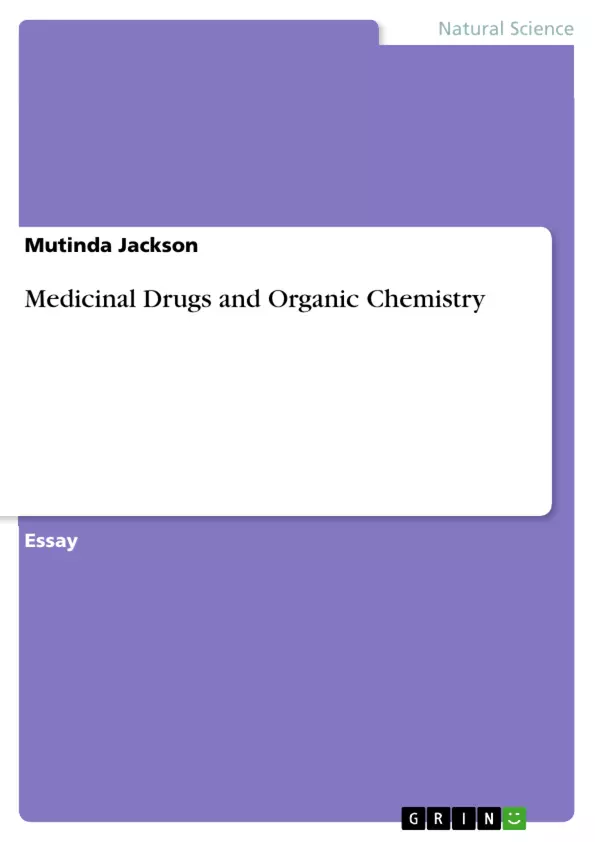Medicinal chemistry refers to the science dealing with the discovery along with design of novel therapeutic chemicals/bio-chemicals, and their respective development into useful medicines. It is a phenomenon that may comprise of compounds isolation from nature or new molecules synthesis, investigation of the connections between natural and/or synthetic compounds and their biological processes. Again, it may involve elucidations of these compounds’ interactions with varied receptors such as DNA and enzymes, determination of their absorption, distribution and transport properties, and metabolic transformation studies of these chemicals, excretion and their toxicity.
Notably, since the 1960s, current techniques for discovering new drugs have incalculably evolved in line with phenomenal organic chemistry, physical chemistry, analytical chemistry, pharmacology, biochemistry and therapeutic advances. With respect to organic chemistry, it is evident that the modern tools applied in conducting drug design, substantially encompasses the entire vital processes of discovering drugs. Such courses include the application of physical principles, understanding the reaction of the body to the drug and the perceived synthetic organic processes used in the new compound preparation. However, drugs are not usually discovered, but rather a lead compound, which is a prototype compound with significant desirable features like those of pharmacological activities, though undesirable facets may also be present such as toxicity. Significantly, numerous studies have demonstrated a substantial relationship between organic chemistry and drugs as will be explored in this essay.
Table of Contents
- Medicinal Drugs and Organic Chemistry Relationship
- Early Herbal Medicines and Chance Discoveries
- Dichroa febrifuga (Fever Root)
- Ma Huang (Ephedra sinica)
- Cinchona Bark and Quinine
- Foxglove and Cardiac Glycosides
- Penicillin and the Discovery of Antibacterial Agents
- Serendipitous Discoveries: Librium and Benzodiazepine Tranquilizers
Objectives and Key Themes
This essay explores the historical and scientific connections between organic chemistry and the development of medicinal drugs. It examines the significance of organic chemistry in drug design, the evolution of drug discovery methods, and the impact of serendipitous discoveries on the field of medicine.
- The role of organic chemistry in drug discovery and development
- Historical examples of chance discoveries of medicinal drugs
- The evolution of drug discovery techniques from traditional herbal medicine to modern pharmaceutical approaches
- The impact of serendipitous discoveries on the development of key therapeutic agents
Chapter Summaries
- Medicinal Drugs and Organic Chemistry Relationship: This section introduces the concept of medicinal chemistry and its relationship to organic chemistry. It highlights the importance of organic chemistry in drug design, synthesis, and understanding the biological interactions of drug molecules.
- Early Herbal Medicines and Chance Discoveries: This section explores the history of drug discovery, focusing on early examples of herbal medicines found by chance, including the discovery of Dichroa febrifuga, Ma Huang, Cinchona bark, and Foxglove. Each example highlights the use of traditional remedies and their later scientific investigation.
- Penicillin and the Discovery of Antibacterial Agents: This section focuses on the discovery of penicillin, a revolutionary antibiotic. It describes the serendipitous nature of Alexander Fleming's observation and the subsequent development of penicillin as a therapeutic agent.
- Serendipitous Discoveries: Librium and Benzodiazepine Tranquilizers: This section examines the serendipitous discovery of Librium, a benzodiazepine tranquilizer. It describes the unexpected synthesis of the compound and its eventual adoption as a therapeutic agent.
Keywords
The essay explores the fundamental relationship between organic chemistry and medicinal drug discovery. Key concepts include drug design, drug synthesis, biological interactions, traditional medicine, serendipitous discoveries, penicillin, benzodiazepines, and the evolution of drug discovery techniques.
- Quote paper
- Mutinda Jackson (Author), 2018, Medicinal Drugs and Organic Chemistry, Munich, GRIN Verlag, https://www.grin.com/document/418785



